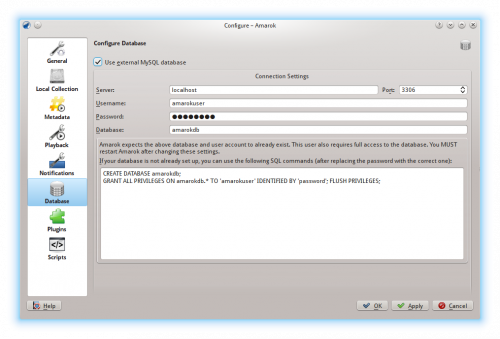Amarok/Manual/Organization/Collection/ExternalDatabase
Vnější databáze
Amarok 2.2 and above support an external MySQL database as a backend.
Nastavit server
Instalovat server MySQL
First you need to install an MySQL server. On Debian-based distributions like Ubuntu you can use
sudo apt-get install mysql-server mysql-client
to install it. You will be asked to specify a password for the root-account for the database. The mysql-client package is needed in order to execute some of the commands in this document, but it's not fundamental to the use of Amarok.
Nastavit databázi
Připojit k místní databázi pomocí
mysql -u root -p
Budete vyzván k zadání hesla pro uživatele root MySQL. Dostanete výzvu
mysql>
.
Create a new user amarokuser with the password amarokpass using the
CREATE USER ''''amarokuser''''@''''localhost'''' IDENTIFIED BY ''''amarokpass'''';
command. Amarok needs its own database, which is created with
CREATE DATABASE '''amarokdb''';
Give the new user access to the database by entering the
GRANT ALL ON '''amarokdb'''.* TO ''''amarokuser''''@''''%'''' IDENTIFIED BY ''''amarokpass'''';
command, where % is a wildcard to allow all hosts to connect to the database. Now use the
FLUSH PRIVILEGES;
statement to reload various internal caches used by MySQL. Finally
exit
closes the MySQL prompt.
By default the server can only be accessed by the local host. To change this you need to edit the file /etc/mysql/my.cnf and adjust the address near bind-address to the one your server listens on the network. 0.0.0.0 listens on all interfaces. After that you need to restart the server using
sudo service mysql restart
Nastavit klienta
Open the configuration dialog by clicking . Enable the checkbox and enter the user data.

Musíte Amarok spustit znovu, aby se změny mohly projevit.
Přestěhování z MySQL Embedded do MySQL Server
If you want to maintain the statistics, etc. that you have in the embedded MySQL database from before Amarok 2.2, you can do the following: First, start Amarok 2.2+ at least once to give the database a chance to update to the latest schema version.
Next, kill the running MySQL service
sudo /etc/init.d/mysql stop
and start a MySQL daemon from your ~/.kde4/share/apps/amarok directory (--defaults-file MUST be the first option!):
/usr/sbin/mysqld --defaults-file=`pwd`/my.cnf --default-storage-engine=MyISAM --datadir=`pwd`/mysqle --socket=`pwd`/sock --skip-grant-tables
The skip-grant-tables means you can use any password or username to connect to it. 'localhost' will not work, the MySQL client will try to use a Unix socket. Using 127.0.0.1 as the host makes it work. Some systems may restrict this access through apparmor or SELinux. They can be temporarily disabled with
sudo /etc/init.d/apparmor stop
Now, run mysqldump, passing in the -S option to specify the local socket. This will dump your old embedded DB out to a SQL file.
mysqldump -S sock amarok > amarok.mysql
You can then restart your MySQL service and load this SQL file into your MySQL server. You'll have needed to already run the GRANT statement above and create an Amarok database ("CREATE DATABASE amarok;"):
sudo /etc/init.d/mysql stop
mysql -u amarokuser -p amarok < amarok.mysql

